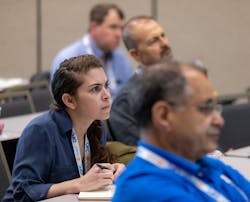A look through the conference program for OFC 2022 will reveal speakers from the usual list of well-established optical communications technology suppliers as well as a wide assortment of research centers (and centres), universities, colleges, institutes, écoles, and whatnot. However, it would not be surprising to see a company or two you may not know well, if at all. The same may also be true upon perusal of the exhibitor list.
Some of these companies may be relatively young; others may have recently rebranded. All would like a bit of your time and attention. So, as a public service, here is some background on a few companies that may not be familiar to you but it might benefit you to know.
In the conference sessions
Several presenting companies in 2022 made their debuts around the OFC 2021 timeframe but may have escaped your notice. For example, Mountain View, CA, based Avicena Tech Corp. focuses on chip-to-chip communications for high-performance computing, cloud computing, and data center networking using a combination of micro-LEDs from the display world and multicore fiber similar to what’s found in imagery applications.
Central to Avicena’s LightBundle architecture are Cavity-Reinforced Optical Micro-Emitters (CROMEs) based on GaN micro-LEDs. These visible blue light emitters typically can transmit less than 1 Gbps of information but Avicena has developed a way to increase that by 10X. The CROMEs are bonded to CMOS in a highly parallel array alongside arrays of silicon photodetectors (PDs) grown directly in CMOS. The technology can enable 10 Tbps per square millimeter at a power efficiency of less than 0.5 pJ/bit, company sources have told Lightwave. The CROME emitters operate at ASIC temperatures, meaning they can serve reliably as internal laser sources for co-packaged optics without cooling.
The multicore fibers will connect to the CROME/PD combinations via passive alignment. Avicena expects the fiber, in a diameter of about 1 mm, to support hundreds of channels initially and thousands of channels eventually. However, development work on the multicore fiber now being used in applications such as endoscopy will be required to support such channel counts, Avicena acknowledges.
The company introduced the LightBundle concept to OFC 2021 attendees via a post-deadline paper. Here, the company described a demonstration of an array of more than 200 devices at a 30-mm pitch coupled simultaneously through a 0.5-mm imaging fiber. As 10G drivers were not available then in an array format, the CROME arrays were driven at 2 Gbps. However, the engineers conducting the demonstration also were able to package the CROME with an external driver to achieve 10 Gbps. At OFC 2022, Avicena CEO Bardia Pezeshki (most recently CEO of Kaiam) will deliver “W1E.1: Microled Array-Based Optical Links Using Imaging Fiber for Chip-to-Chip Communications” as a paper Wednesday, March 9, in which he will undoubtedly report on the company’s progress since last June.
Ayar Labs is another young company focused on chip-to-chip communications and co-packaged optics that will present a paper during the show. The company’s optical I/O approach features 5x9-mm TeraPHY silicon chiplets paired with SuperNova external lasers. The chiplets, which feature micro-ring resonator-based modulation, are designed to be integrated within the packaging of the semiconductor via a multi-chip module approach using normal processes, whether in-house or third-party.
The laser/chiplet combination is designed to support transmission distances of 2 km. Via a post-deadline paper at OFC last year, Ayar reported on a demonstration of a TeraPHY chiplet with eight optical ports providing error-free transmission of 1.024 Tbps at less than 5 pJ/bit. The error-free status was obtained without recourse to forward error correction (FEC). The SuperNova external laser source showed the ability to generate 64 addressable wavelengths based on laser array technology from MACOM.
The company believes its approach can benefit datacom and telecom networking, aerospace and government, and high-performance computing and artificial intelligence applications. An Ayar Labs source told Lightwave at the end of 2020 that he expected the company will begin small volume production perhaps as early as the beginning of this year. Dr. Mark Wade, co-founder and CTO of Ayar Labs, likely will provide updates via the talk he's scheduled to provide on Tuesday (which, as of this writing, remains without an announced title) as part of Tu2A Symposia: Emerging Photonic Interconnects and Architectures for Femtojoule per Bit Intra Data Center Links Session I.
Thursday will see the presentation of “Th1J.1: BTO-Enhanced Silicon Photonics – a Scalable PIC Platform with Ultra-Efficient Electro-Optical Modulation,” from Lukas Czornomaz, co-CEO and founder of Lumiphase AG. “BTO” stands for “Barium Titanate,” which Lumiphase asserts enables low-power, low-optical-loss silicon photonics modulators to enable Mach-Zhender interferometers and other optical processing devices, according to a report in eeNews Europe. In the paper description, Czornomaz touts BTO’s strong Pockels effect, which relates to changes in refractive index – which are very fast in BTO – with the application of an electric field. Lumiphase states on its website that BTO enables “[u]nprecedented piezo- and ferro-electric properties on silicon.”
The company spun out of IBM Europe, which did early work on such devices, at the beginning of 2020. At the time the article appeared last July, Lumiphase was contemplating a Series A funding round for either late in 2021 or at some point this year to help it produce products for the communications, optical computing, and sensing markets. The company has its headquarters in Zurich, Switzerland.
Europe – specifically, France – also is home to SCINTIL Photonics; CEO Sylvie Menezo will discuss the company’s work in silicon photonics Tuesday in “Tu2A.2: (Integrated or Not?) Laser Source for a Few pJ/bit DWDM Links” in the same session in which Ayar Labs’ Wade will speak. The fabless company was founded in Grenoble in November 2018 by Menezo, previously with CEA-Leti, and Chairman Pascal Langlois, former CEO of Tronics Microsystems. SCINTIL Photonics has developed a silicon photonics platform in which it can integrate multi-wavelength lasers. In a 2020 interview with Lightwave, Pascal said that the company can combine silicon, indium phosphide, germanium, and silicon nitride in a CMOS compatible process it calls BackSide-on-BOX. The process sees unprocessed InP/III-V dies bonded on the backside of processed silicon-on-insulator (SOI) wafers, only where it is needed – hence the name. BackSide-on-BOX enables integration of laser arrays and other active and passive components and functions to support applications such as multi-channel 800 Gigabit Ethernet without the need for hermetic packaging.
SCINTIL has secured an agreement with a commercial foundry for PIC production; at the time of the interview, Pascal expressed hope that the company could deliver commercial photonic integrated circuits (PICs) at some point this year.
Finally, Sivers Photonics isn’t a new company – but it has a relatively new name. The company has its roots in CST Global (also known as Compound Semiconductor Technologies), an independent manufacturer of III-V photonic devices that Sivers IMA Holding purchased in 2017. The company provides custom, foundry services in wafer, coated bar, chip device and die on tape formats. Sivers IMA Holding changed its name to Sivers Semiconductors in 2020 – and concurrently changed the name of the subsidiary formed by the former CST Global to Sivers Photonics AB.
Andy McKee, Sivers Photonics, will discuss “Recent Advances in InP Laser Sources for SiPh Hybrid Integration” Wednesday as part of a panel on Progress and Roadmap in Silicon Photonics Foundries and Supply Chains (W1B).
Exhibit floor programming
Two young companies that are delivering commercial products will be among the participants in some of the exhibit hall programming. For example, Lumenisity will attempt to top the splash it made during last OFC with its hollowcore fiber. The company’s nested anti-resonant nodeless fiber (NANF) approach, developed at the University of Southampton in the UK, caught the eye of BT Labs, which conducted several tests and demonstrations of the technology that were discussed around the time of the 2021 show. Lumenisity also announced results of a demonstration of coherent transmission over the NANF hollowcore fiber with Ciena.
The next day, at 12:20 pm, POET Technologies Inc. will participate in a Technology Showcase with the presentation, “Hybrid Integration Platform for Co-Packaged Photonics Using POET’s CMOS Based Optical Interposer.” POET develops and sells a variety of optical engines for transceivers, as well as the O-Band LightBar applicable to co-packaged optics (CPO) applications. The products are based on the company’s POET Optical Interposer, which leverages integrated spot-size converters designed to minimize coupling losses and increase laser power efficiency. The approach enables straightforward integration of photonic elements such as waveguides, filters, and gratings, as well as passive alignment of lasers for flip-chip bonding, according to the company.
POET demonstrated these technologies at last year’s OFC. Since then, the company has announced a pair of customers for its optical engines, one of whom is Shenzhen Fibertop Technology Co., Ltd.
Swing by the booth
On the show floor, HyperLight Corp. will be making its OFC debut. The company, co-founded out of Harvard by CEO Dr. Mian Zhang and Head of Product Dr. Christian Reimer, focuses on the use of thin-film Lithium Niobate (LiNbO3) technology as part of an electro-optic photonic integrated circuit (PIC) platform. Zhang told Lightwave last fall that he expects HyperLight’s technology will enable thin-film LiNbO3 modulators that require less than 1-V driving voltages while supporting greater than 100-GHz bandwidth. Working with Nokia Bell Labs, an early version of the platform demonstrated a 700.5-Gbps line rate and 538.8-Gbps net rate with intensity-modulated and direct detect (IM-DD) signals over 10.2 km of single-mode fiber. However, Zhang says the company and Nokia Bell Labs have since demonstrated coherent transmissions up to 1.58 Tbps at 200 GBaud. Both results required only a single thin-film LiNbO3 modulator, he said. A generally available product using the thin-film LiNbO3 technology is still “a couple of years away,” Zhang’s stated during the interview.
Finally, a company whose name may make your brow furrow initially as you pass by its booth is Quantifi Photonics – until you realize that the company used to be called Coherent Solutions (and, before that, Southern Photonics). The test and measurement technology developer, which made its mark in coherent transmission testing, changed its name in the fall of 2020 to signal a wider scope of activities. The New Zealand-based company completed an oversubscribed Series B funding round of $10 million last July designed to fund expansion of its activities in North America.
Of course, there are many factors that combine to determine how familiar a company may be. Whether mentioned here or discovered via a look through the OFC conference schedule or exhibition list, exploring a company whose story is unfamiliar to you could reveal valuable discoveries.
STEPHEN HARDY is editorial director of Lightwave.
About the Author

Stephen Hardy
Editorial Director and Associate Publisher, Lightwave
Stephen Hardy is editorial director and associate publisher of Lightwave and Broadband Technology Report, part of the Lighting & Technology Group at Endeavor Business Media. Stephen is responsible for establishing and executing editorial strategy across the both brands’ websites, email newsletters, events, and other information products. He has covered the fiber-optics space for more than 20 years, and communications and technology for more than 35 years. During his tenure, Lightwave has received awards from Folio: and the American Society of Business Press Editors (ASBPE) for editorial excellence. Prior to joining Lightwave in 1997, Stephen worked for Telecommunications magazine and the Journal of Electronic Defense.
Stephen has moderated panels at numerous events, including the Optica Executive Forum, ECOC, and SCTE Cable-Tec Expo. He also is program director for the Lightwave Innovation Reviews and the Diamond Technology Reviews.
He has written numerous articles in all aspects of optical communications and fiber-optic networks, including fiber to the home (FTTH), PON, optical components, DWDM, fiber cables, packet optical transport, optical transceivers, lasers, fiber optic testing, and more.
You can connect with Stephen on LinkedIn as well as Twitter.

